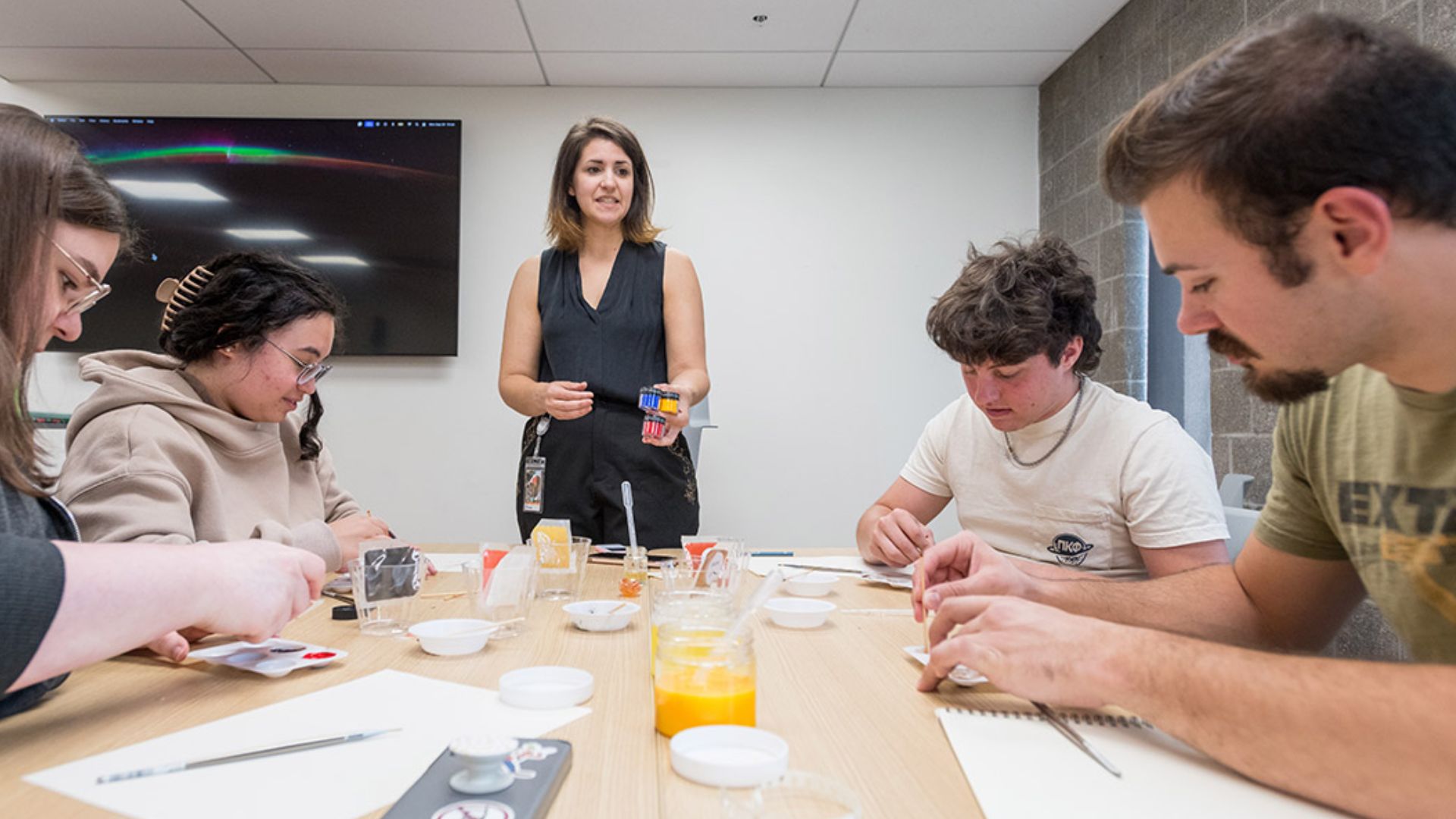Local News
Ph.D. candidate inspires students to explore the hidden history of books by learning to judge them through their materials and design

Rochester, New York – Inside a quiet classroom in RIT’s Wallace Library, the rustle of parchment, the scent of old ink, and the shimmer of hand-mixed pigments transport students hundreds of years back in time. At the front of the room stands Leah Humenuck, a professional paper conservator and Ph.D. candidate in color science, who believes that every book tells a story — not only through its words, but through the materials that hold them.
This semester, Humenuck is putting her lifelong fascination with paper, ink, and pigment into practice by teaching The Secret Lives of Books, a special topics elective in the College of Liberal Arts’ museum studies program. The class dives deep into the physical and historical evolution of the book, from the age of parchment and illuminated manuscripts to the rise of Gutenberg’s printing press and modern paper production.
While many courses focus on the content between a book’s covers, Humenuck’s class takes a different approach. She invites students to literally judge a book by its cover — and its stitching, paper texture, and ink composition. “There’s more than one way to read a book,” Humenuck said. Through her lessons, students learn how materials and construction reveal as much about history, technology, and culture as the printed words themselves.
Her curriculum alternates between lectures and hands-on lab sessions. Students spend time mixing their own pigments, creating sheets of handmade paper, and studying the anatomy of rare books up close. They also explore the art of book storage and preservation — essential skills for anyone considering a future in museum or archival work. “I think the best way to interact with history is to do the history,” Humenuck added.
For many students, the experience is unlike any class they’ve taken before. Christis Shepard, a fourth-year museum studies major from Bayonne, New Jersey, said the course has opened her eyes to the complexity of early bookmaking. “We’re currently learning about medieval books, the inks medieval scribes and artisans used, and the techniques used in creating parchment,” Shepard said. “It makes me appreciate the ease we have today in making books and that many of these old books managed to survive into the modern day.”
Much of the class takes place inside RIT’s Cary Graphic Arts Collection — a world-renowned archive of rare books, printing equipment, and design history located in Wallace Library. The collection gives students direct access to centuries of material culture. “I wanted to create a class that would intersect with the Cary Collection,” Humenuck said. “I tell my students, ‘While you’re here, use the Cary Collection because it’s phenomenal.’”
The idea for The Secret Lives of Books was born from a conversation between Humenuck and Juilee Decker, director of the museum studies program and co-director of the Cultural Heritage Imaging Lab. Decker immediately recognized that Humenuck’s unique blend of scientific expertise and artistic sensitivity could enrich the program. “I enjoy tapping into what students are doing at the graduate level and seeing how they might inform what we’re doing in museum studies,” Decker said. “I thought that Leah’s expertise as a book and paper conservator would provide a materials perspective on a topic that is related to museum studies.”
With its mix of science, history, and artistry, RIT’s museum studies program is one of only a handful of undergraduate programs of its kind in the United States. It combines traditional humanities with technology, preparing students for careers in libraries, archives, and museums. Decker said the program’s interdisciplinary structure — drawing from several colleges and departments — creates a perfect space for experimental courses like Humenuck’s.
The Cary Graphic Arts Collection, curated by Steven Galbraith, complements Humenuck’s teaching by offering a parallel course on the history of the book from a curatorial perspective. Faculty from RIT’s Image Permanence Institute add further depth with courses focused on preservation and collections care. Together, these experiences help students understand books as living artifacts — delicate intersections of art, science, and storytelling.
Decker said Humenuck’s involvement has also strengthened the mentoring network within the program. “Leah has served as a mentor and an internship supervisor for a number of my students,” she said. “I work with her in a research capacity, so I am aware of her excellent scholarship ethics and her keen eye toward mentoring and developing lifelong learning goals for people.”
For Humenuck, the opportunity to design and teach her own course is both a professional milestone and a personal dream. Every Ph.D. student’s path to the classroom looks different, and for her, this semester marks her first time writing a syllabus, planning a semester-long curriculum, and leading a college course from start to finish.
Decker provided guidance throughout the process, helping Humenuck navigate course parameters and learning objectives — and even sitting in on classes to observe. “It’s common that there’s not a precursor to teaching,” Decker said, recalling her own graduate experience. “There isn’t a formal class that says, ‘This is how you become an instructor now that you want to share your knowledge of this topic.’”
Before stepping into her current role, Humenuck built her teaching skills through guest lectures, conference presentations, and the development of an internship program within museum studies. She also served as a graduate teaching assistant for Fundamentals of Color Science, a course that explored how human vision and technology intersect to interpret color.
Christie Leone, assistant dean of the RIT Graduate School, said the university offers many ways for graduate students to gain teaching experience. Graduate teaching assistants (GTAs) work closely with faculty mentors and are required to complete GTA Foundations, a training course developed in collaboration with the Center for Teaching and Learning. The program helps future instructors learn classroom management, communication, and assessment strategies before they take on teaching duties.
Humenuck’s latest role goes beyond assisting — she is now fully leading her own classroom. The elective has drawn 17 students from diverse majors, including museum studies, graphic design, and even engineering. This mix of backgrounds and interests has made for lively discussions and fresh perspectives on the book as a technological and artistic object. “Being able to answer questions and pull a class together withstudents having different perspectives is something I really enjoy,” Humenuck said.
Through The Secret Lives of Books, she’s finding her own rhythm as an educator — balancing theory with practice, structure with curiosity. Her approach encourages students not only to see books as sources of information but also to feel their weight as artifacts that connect us across centuries.
In a world where most reading happens on glowing screens, Humenuck’s course serves as a reminder of the tactile beauty of the printed page — the grain of the paper, the pressure of the press, the texture of time itself. As she helps her students judge books by their covers, she’s also guiding them to look deeper: into the hands that made them, the science that preserves them, and the stories they continue to tell long after the ink has dried.

-

 Local News10 months ago
Local News10 months agoNew ALDI store close to Rochester to begin construction in late 2025 or early 2026
-

 Local News10 months ago
Local News10 months agoRochester Lilac Festival announces exciting 127th edition headliners
-

 Local News7 months ago
Local News7 months agoCounty Executive Adam Bello and members of the county legislature celebrate exceptional young leaders and advocates at the 2025 Monroe County Youth Awards
-

 Local News7 months ago
Local News7 months agoThe 2025 Public Market Food Truck Rodeo series will begin this Wednesday with live music by the Royal Bromleys